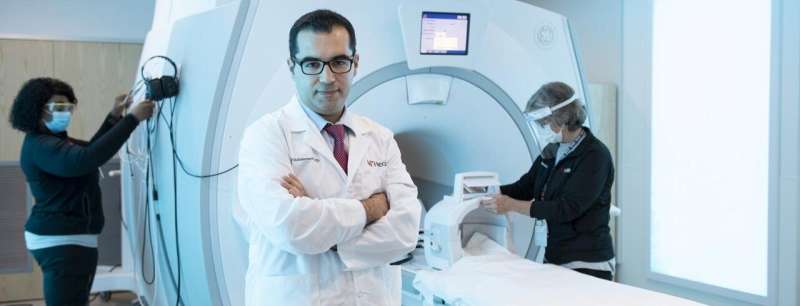
Since the pandemic hit, researchers have been uncovering ways COVID-19 impacts other parts of the body, besides the lungs.
Now, for the first time, a visual correlation has been found between the severity of the disease in the lungs using CT scans and the severity of effects on patient’s brains, using MRI scans. This research is published in the American Journal of Neuroradiology. It will be presented at the 59th annual meeting of the American Society of Neuroradiology (ASNR) and has also been selected as a semifinalist for that organization’s Cornelius Dyke Award.
The results show that by looking at lung CT scans of patients diagnosed with COVID-19, physicians may be able to predict just how badly they’ll experience other neurological problems that could show up on brain MRIs, helping improve patient outcomes and identify symptoms for earlier treatment.
CT imaging can detect illness in the lungs better than an MRI, another medical imaging technique. However, MRI can detect many problems in the brain, particularly in COVID-19 patients, that cannot be detected on CT images.
“We’ve seen patients with COVID-19 experience stroke, brain bleeds and other disorders affecting the brain,” says lead author Abdelkader Mahammedi, MD, assistant professor of radiology at the University of Cincinnati and a UC Health neuroradiologist. “So, we’re finding, through patient experiences, that neurological symptoms are correlating to those with more severe respiratory disease; however, little information has been available on identifying potential associations between imaging abnormalities in the brain and lungs in COVID-19 patients.
“Imaging serves as proof for physicians, confirming how an illness is forming and with what severity and helps in making final decisions about a patient’s care.”
In this study, which was conducted not only at UC, but also at large institutions in Spain, Italy and Brazil, researchers reviewed electronic medical records and images of hospitalized COVID-19 patients from March 3 to June 25, 2020. Patients who were diagnosed with COVID-19, experienced neurological issues and who had both lung and brain images available were included.
Of 135 COVID-19 patients with abnormal CT lung scans and neurological symptoms, 49, or 36%, were also found to develop abnormal brain scans and were more likely to experience stroke symptoms.
Mahammedi says this study will help physicians classify patients, based on the severity of disease found on their CT scans, into groups more likely to develop brain imaging abnormalities. He adds that this correlation could be important for implementing therapies, particularly in stroke prevention, to improve outcomes in patients with COVID-19.
“These results are important because they further show that severe lung disease from COVID-19 could mean serious brain complications, and we have the imaging to help prove it,” says Mahammedi, who is also a member of the UC Gardner Neuroscience Institute. “Future larger studies are needed to help us understand the tie better, but for now, we hope these results can be used to help predict care and ensure that patients have the best outcomes.”
Katie Pence, University of Cincinnati

